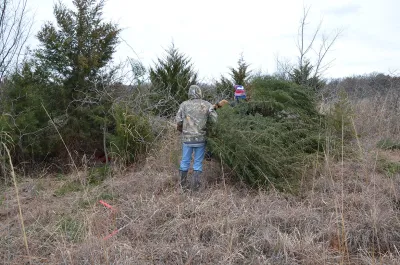A plague to much of Oklahoma's landscape, eastern redcedars have a reputation for spreading into prairies, woodlands and even backyard wildscapes. Lopping young cedars below the lowest growing branch is one way to rid your wildscape of these native but encroaching trees.

Historically limited to steep draws or canyons where naturally-occurring or human-lit fire couldn't regularly reach, eastern redcedars have now spread across most of Oklahoma, including many backyard wildscapes. Eastern redcedars are native, but are extremely aggressive and can overtake small openings and outcompete many other beneficial plant communities like prairies and savannahs. In backyards, this means less space for flowering plants that can attract butterflies and hummingbirds, as well as less space for more diverse fruiting trees and other seed producing plants that can attract many songbirds. In rangelands, these trees can limit habitat for ground nesting birds and reduce cattle grazing opportunities.
Though eastern redcedars can be a headache for land managers across most of the state, they do have a few wildlife benefits. Many birds and small mammals take advantage of the tree's evergreen branches for shelter year-round, but especially on cold winter days. In addition to shelter, these trees provide a source of food; a wide variety of songbirds forage on the tree's cones, or "berries."
Unfortunately, the same wildlife that benefit from the trees can also add to Oklahoma's redcedar invasion. Songbirds often spread these trees when they "perch and plant" seeds along fencerows and under mature hardwoods. Without some sort of management, these encroaching redcedars can quickly overcome prairies, savannahs and woodlands. Some managers use prescribed fire to control small redcedars, but smaller landowners may be able to manage the eastern redcedar invasion by cutting trees below the lowest growing branch. This mechanical removal will need to be repeated as new trees sprout, or are "planted" by songbirds or other wildlife. The lopped trees can be piled and burned or left on the landscape to skeletonize.
Lopping Cedars at Arcadia Conservation Education Area
Last month, high school volunteers from Oklahoma Christian School helped the Arcadia Conservation Education Area manager remove hundreds of small redcedars from the lake view of the education building using loppers and hand saws. The students endured freezing weather conditions to provide the hands-on habitat management while learning about the benefits of redcedar removal and other removal techniques, including prescribed fire.

